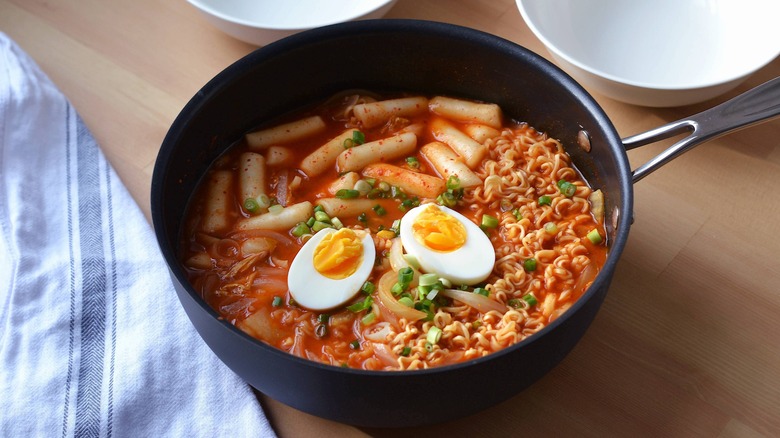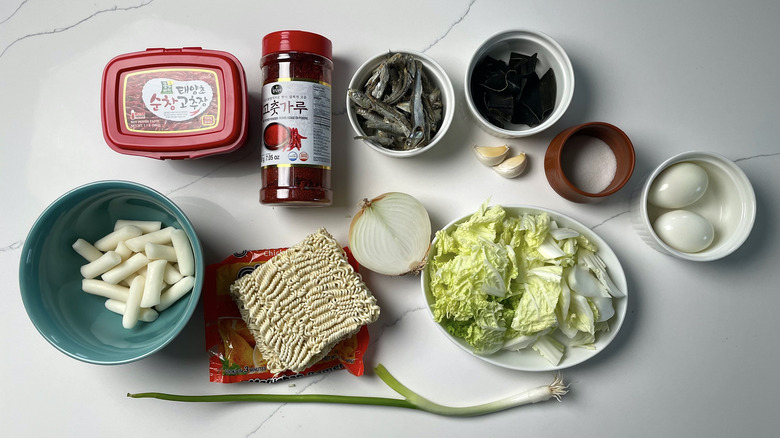Carbs On Carbs Rabokki Recipe
While carbohydrates have been somewhat demonized over the past few decades as keto and paleo diets have become popular, the fact is this: They are a nutrient like any other, and you do, in fact, need them in your diet. If you're looking to boost your daily carb count, recipe developer Rika Hoffman calls this carb on carb rabokki "an easy weeknight dinner to jazz up your basic instant ramen brick." The other carb is Korean-style rice cakes, as rabokki is a portmanteau that mashes up ramen and tteokbokki.
Much of the depth of this rabokki comes from a rich anchovy-kelp stock that you'll make from scratch, which Hoffman assures takes only a few minutes and is "completely worth it for the flavor payoff." She also notes that this "comforting, filling, and mildly spicy" recipe can be customized to your tastes with the addition of a protein, such as fish cakes or hot dogs and Spam in the spirit of budae jjigae, or mozzarella for an enticing cheese pull with every scoop.
Collect the ingredients for this carb on carb rabokki
Some rabokki ingredients may only be available from Asian or specialty supermarkets, including the dried anchovies, dried kelp, tteok rice cakes, gochujang, and gochugaru. The other ingredients you may already have on hand or can find just about anywhere: sugar, garlic, an onion, Napa cabbage, instant ramen noodles, eggs, and scallions (which are essentially the same as green onions).
Prepare the anchovy-kelp broth
For starters, snap the heads off the anchovies and split open the bodies to take out the black guts. (These you can just toss.) While Hoffman uses larger anchovies because, as she explains, they "tend to be more flavorful than the tiny ones," she does say that "smaller anchovies can be used whole without removing the guts" in case you're squeamish about this step or would just like to save a little time.
Once you've gotten the fish prep out of the way, wipe off the kelp to clean it with a damp towel. Put it in a pot with the anchovies and water and let the mixture sit for at least 30 minutes, although Hoffman says a soak of several hours or even overnight will give the broth a more intense flavor.
Cook the anchovy-kelp broth
When you're ready to cook the rabokki, put the pot of water, anchovies, and kelp on a burner set to medium-high and bring it to a boil. Simmer it for 10 minutes, then skim out the solids and keep simmering the clear broth for another 10 minutes.
"The amount of water used in this recipe makes for rabokki that isn't too soupy or too dry," Hoffman says, noting that you can reduce the water by up to ½ cup for a thicker sauce. For a soupier consistency, add ½ cup water.
Add the rest of the ingredients
While the broth is simmering, you can soak the tteok in boiling water for 10-20 minutes to soften them up. If you're using fresh as opposed to refrigerated or frozen rice cakes, though, Hoffman says "you can skip the soaking step and cook them directly in the broth."
When the broth is done simmering and the tteok are done soaking (if necessary), combine the gochujang, sugar, garlic, and gochugaru in a small bowl. Stir this sauce mixture into the broth and let it boil for a few minutes, then add the onion, cabbage, and tteok. Boil these for a minute, then slide the ramen bricks into the water and let them cook until they are tender (typically about 3 minutes).
When your rabokki is done cooking, top it with the boiled eggs and scallions, and dig in. Be sure to eat this dish up all in one sitting, as Hoffman warns that leftover noodles in broth tend to get unpleasantly soggy. As she advises, "If cooking for one, I'd recommend halving the recipe and making a single serving portion."

- 24 large dried anchovies (each about 3 inches in length)
- ½ ounce (or about 12 grams) dried kelp
- 5 ½ cups water
- 4 tablespoons gochujang
- 2 tablespoons sugar
- 2 cloves garlic, minced
- 2 teaspoons gochugaru
- ½ large onion, sliced
- 2 Napa cabbage leaves, cut into large bite-size pieces
- 30 cylindrical tteok rice cakes (soaked in boiling water for 10-20 minutes if purchased refrigerated or frozen)
- 2 (3-ounce) packages instant ramen noodles
- 2 hard-boiled eggs, halved lengthwise
- 2 scallions, thinly sliced
- Remove and discard the anchovy heads, then split the bodies open to remove the black innards.
- Wipe the kelp with a damp cloth or paper towel.
- Put the anchovies, kelp, and water in a pot and let sit for at least 30 minutes. For optimal flavor, let it soak for several hours or overnight.
- Bring the pot of water, anchovies, and kelp to a boil over medium-high heat.
- Simmer the broth for 10 minutes, then remove the kelp and anchovies.
- Simmer the broth for an additional 10 minutes.
- In a small bowl, mix the gochujang, sugar, garlic, and gochugaru.
- Stir the gochujang mixture into the pot and boil it for a couple of minutes.
- Add the onion, cabbage, and tteok and cook these for 1 minute.
- Add the instant noodles and cook these for about 3 minutes or until tender.
- Top the rabokki with the eggs and scallions before eating.




